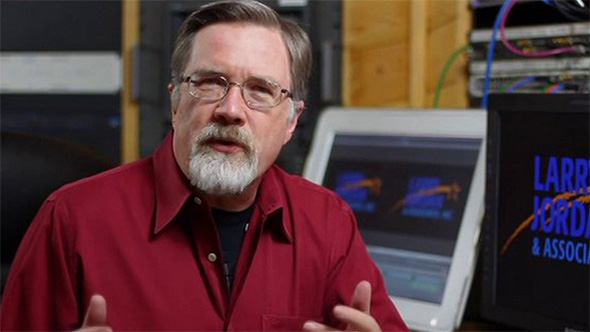
Some people attack NAB with a detailed plan and others simply let the undulating flow of traffic up and down the aisles guide them through the exhibition. Looking for a way to manage your days? We asked Digital Production Buzz's Larry Jordan about the types of products and workflows he'll be searching out in Vegas—including those off everyone's radar. When he's not roaming the halls, Jordan will be recording live updates of the show every 30 minutes between 10:30 and 2:00 pm during NAB.
1: The Industry Is on an Upswing (Finally)
"I think NAB 2014 is going to be a sea change," says Jordan. "We're finally seeing the industry pull itself out of the financial funk that it's been in for the last four or five years. But it's still a rugby scrum out there in many ways. As new products and workflows emerge, the old guard will need to adjust. But we are looking at an industry that is finally getting some cash to spend and the recession finally fading into the background."
2: 4K Workflows Only Start with a Camera
4K has legs that 3D never did, says Jordan, and we already know we'll see every imaginable new 4K camera and beyond at NAB again this year. "Part of the reason is we've been acquiring 4K, 5K and even 6K images for a while and computers have also been able to edit 4K for a while. A Mac mini can edit 4K, for example. But now we have a choice: Are we shooting 4K because we want to edit it at 2K or 1080 so we can use the additional pixels for image stabilization, or do we want to use it for reframing later—which just drives me nuts!—to give us more power during post? So when thinking about 4K, think about all the peripherals like storage, bandwidth and infrastructure that hang off of these recording and editing workflows to support those huge files."
3: New, Better Forms of Storage Are Coming
The computers we have today are now fast enough to do everything we want, says Jordan. "It's what's hanging off the computer where we'll start to see significant changes. Storage continues to increase but I think we'll see it take a left turn, or some turn, later this year. New forms of storage will better combine flash and spinning media, the way that Apple did with its Fusion drive, and performance will increase to start to fill the massive pipes we now have with Thunderbolt 1 and Thunderbolt 2. As we move into higher-resolution images, the file sizes become staggeringly large. The only way we're going to be able to deal with this is either have massive compression like H.265, which will be great for distribution but miserable for editing, or we've got to figure out how to get more performance out of the gear we've already got. I think we're going to see the first sign of this at NAB. Maybe nothing will be shipping at the show, but shortly thereafter we'll see available products."
4: A MAM Accessible to Everyone Could Debut
Building out infrastructures that support geographical distributed collaboration will be another hot-button issue at the show, Jordan says. "I think there will be a lot of interesting advancements in infrastructure, though media asset management is still too arcane and still requires way too much of an IT infrastructure to try to implement it on any kind of a large scale. Axle keeps knocking at the door, and I will be curious to see what Square Box's CatDV and others will do to try to make media asset management more accessible to the masses.
5: A Truly Secure Cloud for Post May Be on the Horizon
"I am such a skeptic about the cloud in terms of security," Jordan says, "and I think it's still the Wild West in the cloud for that reason. The cloud makes great sense for distribution and in collaborative pre-production, but I'm still looking for those applications that give me more of a sense of security and bandwidth so I can actually save time during the post process. I'm going to keep my eyes wide open at NAB."
6: 4K's Killer App: Distributing Indie Films
Now that 4K is a fact of life, what about that last mile to theaters and television sets, particularly UltraHD sets already in production? Jordan notes that, even today, relatively few films are projected theatrically at 4K, and existing television networks are 720p and 1080i. "But, as the brilliant Michael Cioni said on one of my podcasts, what if we bypass traditional distribution? We are already seeing YouTube/Google, Apple TV and Netflix driving a 4K set-top box via the Internet and their existing infrastructure, totally bypassing theatrical distribution and delivering a film at the highest possible quality to the home via the H.265 codec. All of a sudden, a viable market opens up for independent producers to create 4K content to reach consumers directly in their homes. My brain exploded, but he's right. This is what will drive sales of 4K TVs—direct access through Netflix or YouTube of that content."
7: You Could Find Something Revolutionary—and Useful—on the Fringes
"I love prowling the edges of the convention halls to see people who have scraped together all their credit cards and have bought a 10×10 booth at NAB because they have a great idea," admits Jordan. "Invariably, they do. These are the guys that are setting the tone of the industry. The sudden idea that comes in from left field is always in the corner booth in the back in the dark. Of course, how can you not look at the big blaring lights at the front of the hall? I'll give those manufacturers my attention, too. But I'm leaving plenty of time to explore the edges in search of that really cool, new idea."
Did you enjoy this article? Sign up to receive the StudioDaily Fix eletter containing the latest stories, including news, videos, interviews, reviews and more.

Interesting to see your thoughts for this year’s NAB. But I have to take issue with a few of your comments. Seems like a big over-simplification.
You talk about the ease of editing 4K material and that a Mac Mini can handle the task. While maybe a Mac Mini can play some forms of 4K (can you give more details about what 4K it can play and how many streams it can handle) what is the editing experience when cutting with 4K files (including added effects and transitions)? If you add some effects, can you still get smooth playback? Is it able to handle RED playback… because I know with a Mac Pro it can have trouble playing back full quality RED files. I think there might be some technical limitations that you are failing to mention for real 4K editing.
I have major issue with your statement “We are already seeing YouTube/Google, Apple TV and Netflix driving a 4K set-top box via the Internet and their existing infrastructure, totally bypassing theatrical distribution and delivering a film at the highest possible quality to the home via the H.265 codec.”
To say that the playback you describe (4K Youtube/Netflix over the Internet) is delivering a film at the highest possible quality is just plain wrong.
I would argue that audiences that are viewing content in that way are seeing a VERY degraded presentation. You are saying that this 4K Internet streaming is better quality than a well mastered Blu-ray or DCP? The added compression (even with the magical H.265) to squeeze the video and audio down our existing delivery pipelines can do nothing good for the final Video and Audio quality. I honestly think that a more lightly compressed (or one using higher bit depth and color gamut) 1080P version would look superior to your highly compressed 4K image. Why not use this H.265 codec to make our 1080P home viewer even more dynamic and impressive. I guess I’m just a fan of quality over quantity.
-Peter Berg
Peter you raise many good and logical points. But if you’re familiar with Larry Jordan, then you’ll know that over simplification is what Larry sells in spades. He speculates with a passion, but thats about all. Those who drink his Kool Aid are usually editors new to the business.
@Peter Berg-
H265 isn’t ready yet, so who knows how magical it really is. Even if it’s very magical, it won’t be enough to convince the average person to get a new Blu Ray player or repurchase remastered Blu Rays for the benefit of just a better picture.
I doubt there will be a simple way to upgrade an existing device to H265.
If anything it would really improve the quality of the 1080p streaming content.
Will 4k streaming be better than what’s currently out there? Who knows. But I don’t think we’ll have to wait too long to find out. Add Rec2020 to the mix and streaming 4k content may be worth it for the average viewer to not care about owning a physical copy.
I would assume Larry Jordan means editing 4k material using some flavor of ProRes on a Mac Mini. Red only recently started supporting GPUs with their software, so I doubt full quality R3Ds will play on Mac Mini.
So you mean editing proxies on a junky mini? We can do that with a junk mac air at this point. True 4K raw editing is not something a mini can do, or most Mac Pros can’t do easily. That’s where PPro on PCs shine. Over-simplification is right, for the Apple masses. For the rest of the world, we know the real deal.